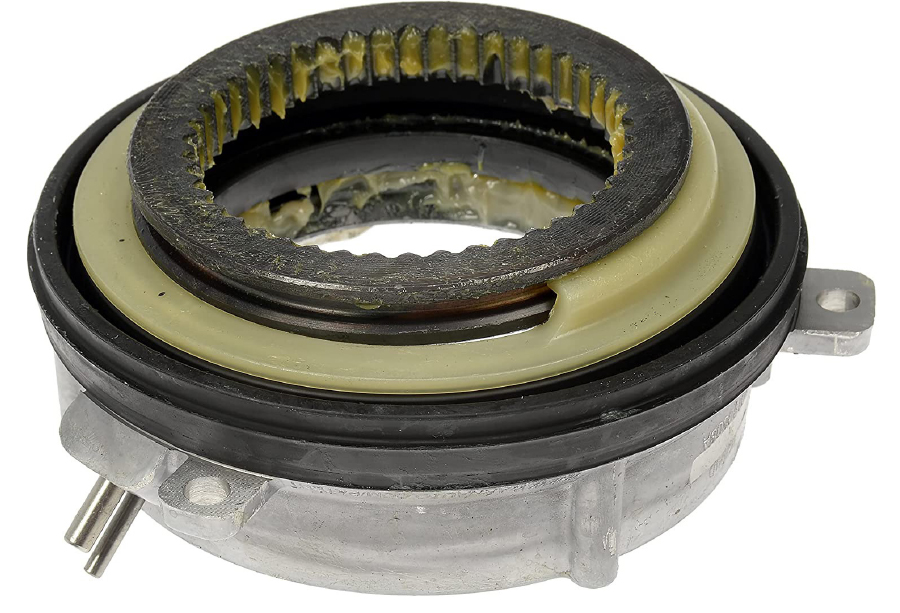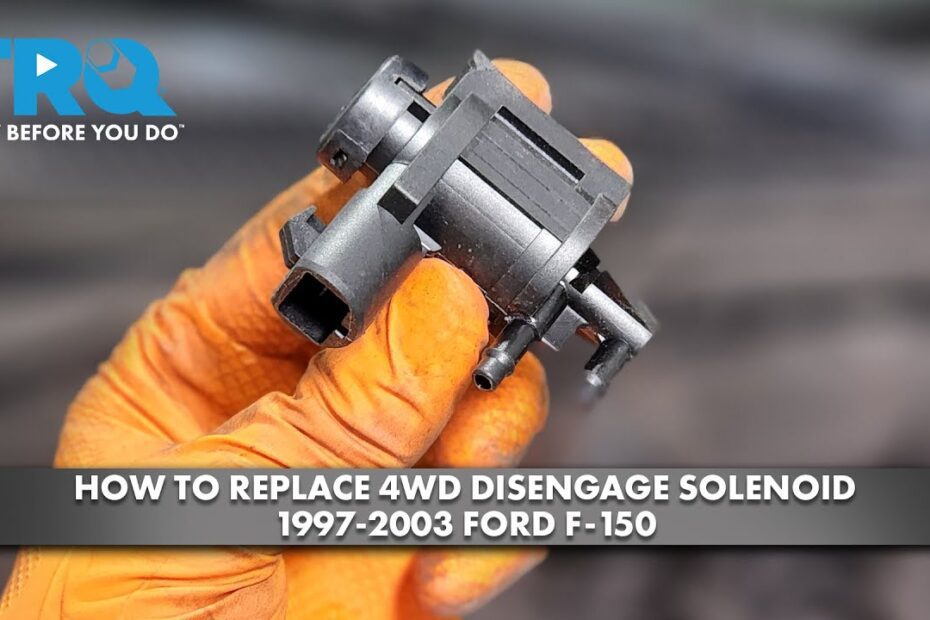To disengage 4-wheel drive in a ford f150, locate the 4wd control switch and turn it to the 2h position. When the indicator light stops blinking and remains solid, the 4-wheel drive is fully disengaged.
Driving a ford f150 equipped with 4-wheel drive can be advantageous in certain off-road or slippery situations. However, there may come a time when you need to disengage the 4-wheel drive system to optimize fuel efficiency or transition back to normal driving conditions.
Understanding how to disengage the 4-wheel drive in a ford f150 is crucial to avoid unnecessary strain on the drivetrain. We will provide a concise guide on how to disengage 4-wheel drive in a ford f150, ensuring a smooth transition back to 2-wheel drive mode.

Credit: www.brakeandfrontend.com
Understanding The Importance Of Disengaging 4 Wheel Drive
When it comes to off-road adventures, having a 4 wheel drive (4wd) vehicle like the ford f150 can give you the power and traction necessary to tackle challenging terrains. However, it is equally important to know how to disengage 4 wheel drive when you are driving on regular roads.
Why It Is Important To Know How To Disengage 4 Wheel Drive
Disengaging your ford f150’s 4 wheel drive system is crucial for a variety of reasons:
- Preserving fuel efficiency: When driving in 4wd mode on dry pavement, your vehicle is consuming more fuel than necessary. Disengaging 4 wheel drive can help improve fuel efficiency, saving you money at the pump.
- Reducing tire wear: Driving in 4wd mode on regular roads can cause excessive tire wear. By disengaging 4 wheel drive, you help prolong the life of your tires, ensuring they last longer and saving you money on replacements.
- Preventing drivetrain damage: Extended use of 4wd mode on dry pavement puts unnecessary strain on your ford f150’s drivetrain. Disengaging 4 wheel drive reduces this strain, minimizing the risk of expensive drivetrain repairs down the line.
- Improving handling and maneuverability: Driving in 4wd mode on regular roads can negatively impact your vehicle’s handling and maneuverability. Disengaging 4 wheel drive restores optimal performance and control, enhancing your overall driving experience.
The potential dangers of driving in 4 wheel drive mode on dry pavement include:
- Limited traction: In 4wd mode, your ford f150 is designed to provide maximum traction on off-road surfaces. However, when driving on dry pavement, the excessive traction can lead to issues such as increased braking distances, reduced steering responsiveness, and even loss of control in certain situations.
- Increased wear on steering components: The added strain of driving in 4wd mode on regular roads can wear out your steering components faster. This can lead to costly repairs and compromise the safety of your vehicle.
- Risk of accidents: Driving in 4wd mode on dry pavement increases the risk of accidents, especially during turns or sudden maneuvers. The excessive traction can cause the tires to grip the road too strongly, leading to skidding or loss of control.
To ensure the optimal performance, safety, and longevity of your ford f150, it is essential to disengage 4 wheel drive when driving on regular roads. By understanding the importance of disengaging 4 wheel drive and knowing how to do it correctly, you can avoid potential dangers, save on fuel costs, prolong the life of your tires, and maintain the overall health of your vehicle.
So, let’s dive into the next section to learn how to disengage 4 wheel drive on your ford f150.
Step-By-Step Guide To Disengaging 4 Wheel Drive
If you’re a proud owner of a ford f150 with 4 wheel drive, you might find yourself in a situation where you need to disengage it. Whether you’re switching to 2 wheel drive for better fuel efficiency or trying to navigate slippery terrain, knowing how to disengage your 4 wheel drive is essential.
Follow this step-by-step guide to effortlessly disengage the 4 wheel drive on your ford f150.
Locate The 4 Wheel Drive Switch Or Dial
Locating the 4 wheel drive switch or dial is the first step in disengaging your ford f150’s 4 wheel drive. Here’s what you need to do:
- Look for the 4 wheel drive switch or dial on your vehicle’s dashboard. It is usually located near the driver’s side, within easy reach.
- Familiarize yourself with the different modes available for your ford f150’s 4 wheel drive system. These typically include 2h, 4h, and 4l. Each mode offers different settings for various driving conditions.
- Take note of the current position of the switch or dial before proceeding to the next step. This will help you understand the changes you need to make.
Shift The Transmission Into Neutral
With the 4 wheel drive switch or dial identified, it’s time to shift the transmission into neutral. Follow these steps:
- Bring your ford f150’s transmission into neutral by pressing the clutch (if it’s a manual transmission) or shifting to neutral (if it’s an automatic transmission). Make sure the vehicle is stationary before making this shift.
- Engaging neutral will prevent any strain or damage to your vehicle’s drivetrain as you switch between 4 wheel drive modes.
Turn The 4 Wheel Drive Switch To The Desired Mode
Now that your transmission is in neutral, it’s time to switch the 4 wheel drive mode. Here’s how you can do it:
- Use the 4 wheel drive switch or dial to select the desired mode based on your driving conditions. Refer to your vehicle’s manual if you’re unsure about which mode to choose.
- Turning the switch or dial counterclockwise usually engages 4h (four-wheel drive high), which is suitable for off-road or slippery conditions. Turning clockwise typically engages 4l (four-wheel drive low), which provides maximum traction for extreme off-road situations. And finally, turning the dial to 2h disengages the 4 wheel drive, making your ford f150 a two-wheel drive vehicle.
Confirm Disengagement By Testing The Vehicle
After selecting the desired 4 wheel drive mode, it’s crucial to confirm that the disengagement was successful. Follow these steps to test your vehicle:
- Slowly drive your ford f150 forward, ensuring that the 4 wheel drive disengagement has taken effect. Listen for any unusual sounds that may indicate the system is still engaged when it shouldn’t be.
- Pay attention to the vehicle’s handling and response. If disengaged correctly, you should notice a difference in how the vehicle maneuvers, as it transitions to the appropriate number of wheels in use.
- If you find any issues or suspect that the disengagement was not successful, consult your vehicle’s manual or reach out to a professional technician for assistance.
Now that you have successfully disengaged the 4 wheel drive on your ford f150, you are ready to navigate the road ahead with confidence and control. Remember to engage or disengage the 4 wheel drive system only when necessary, and always prioritize the safety of yourself and others on the road.
Troubleshooting Common Issues With Disengaging 4 Wheel Drive
The Switch Or Dial Is Not Working Properly
- If you’re having trouble disengaging the 4-wheel drive on your ford f150, the switch or dial could be the culprit. Here are some key points to troubleshoot this common issue:
- Check for any physical damage or debris around the switch or dial. Make sure it is not obstructed or sticking.
- Verify if the switch or dial is properly connected. It might have become loose or disconnected.
- Inspect the wiring harness connected to the switch or dial for any visible damage or loose connections. Ensure it is securely attached.
- If everything appears fine visually, there might be an internal issue with the switch or dial itself. It could be malfunctioning and require replacement.
The Vehicle Is Not Disengaging From 4 Wheel Drive Mode
- If you find that your vehicle is not disengaging from 4-wheel drive mode, there could be underlying problems causing this issue. Consider the following points:
- Double-check that you have followed the correct disengagement procedure outlined in your vehicle’s manual. Ensure you are following the correct sequence of steps.
- Verify the transfer case is functioning properly. It could be stuck or damaged, preventing the vehicle from disengaging properly.
- Inspect the front hubs or front axle actuator (depending on the system in your f150) for any signs of damage or malfunction. These components are responsible for engaging and disengaging the front wheels from the drivetrain.
- Examine the vacuum lines (if applicable to your model) for leaks or cracks. Vacuum-related issues can affect the vehicle’s ability to disengage from 4-wheel drive mode.
- Consider the possibility of a faulty sensor or control module. These electronic components play a crucial role in managing the 4-wheel drive system and may require professional diagnostics.
Possible Reasons For These Issues
Electrical Problems
- Electrical problems can interfere with the proper functioning of the 4-wheel drive system. Here are some possible causes:
- Blown fuses or relays could be disrupting the electrical flow to the system. Check and replace any faulty components.
- Loose or corroded electrical connectors can cause intermittent issues. Ensure all connections are secure and free from corrosion.
- Faulty sensors or control modules may not send or receive accurate signals, leading to difficulties in disengaging 4-wheel drive. Diagnostic equipment can help identify and address these issues.
Mechanical Issues
- Mechanical issues within the drivetrain can also contribute to difficulties in disengaging 4-wheel drive. Consider the following:
- Worn or damaged components such as transfer case gears, front hubs, or axle actuators can impede the disengagement process. Inspect these parts for signs of wear and tear.
- Lack of proper lubrication within the drivetrain can cause components to seize or operate inefficiently. Ensure regular maintenance and lubrication to prevent mechanical issues.
- Misalignment or binding of drivetrain components can prevent smooth operation. Align and adjust these components as necessary.
Remember, troubleshooting complex systems like the 4-wheel drive on your ford f150 may require professional expertise. If you are unsure about any steps or suspect a more significant underlying issue, do not hesitate to consult a qualified mechanic or contact your local ford dealership for assistance.
Tips For Maintaining Your Ford F150’S 4 Wheel Drive System
Owning a ford f150 with a 4 wheel drive system can be a great asset, especially when it comes to traversing challenging terrains or tackling tough weather conditions. However, like any other component of your vehicle, the 4 wheel drive system requires regular maintenance to ensure optimal performance.
In this section, we will discuss some essential tips for maintaining your ford f150’s 4 wheel drive system.
Regularly Checking The 4 Wheel Drive System
To keep your ford f150’s 4 wheel drive system in top condition, it’s vital to perform regular checks. Here are the key points to remember:
- Inspect the 4 wheel drive system for any signs of wear and tear, including damaged or loose components.
- Check the fluid levels in the transfer case and differentials to ensure they are at the recommended levels.
- Look for any leaks in the system, such as oil spots or fluid stains on the ground.
- Test the engagement and disengagement of the 4 wheel drive system to ensure smooth operation.
- Pay attention to any strange noises or vibrations during engagement, as they may indicate underlying issues that require attention.
Following The Manufacturer’S Recommended Maintenance Schedule
Adhering to the manufacturer’s recommended maintenance schedule is crucial for the longevity of your ford f150’s 4 wheel drive system. Consider these points:
- Follow the maintenance intervals outlined in your vehicle’s owner’s manual.
- Regularly change the oil and replace the filters in the transfer case and differentials as per the recommended schedule.
- Have your 4 wheel drive system inspected by a professional at regular intervals, especially if you frequently engage it or operate in extreme conditions.
- Perform any service or repairs as suggested by the manufacturer.
Properly Engaging And Disengaging 4 Wheel Drive
Engaging and disengaging the 4 wheel drive correctly is paramount to avoid unnecessary strain on your ford f150’s system. Take note of the following tips:
- Engage 4 wheel drive only when necessary, such as when driving on slippery or off-road surfaces.
- Before engaging the system, bring your vehicle to a complete stop and shift into neutral. Then, engage the 4 wheel drive mode by following the specific instructions in your owner’s manual.
- When disengaging, again bring the vehicle to a stop, shift into neutral, and follow the provided instructions to disengage the 4 wheel drive mode.
- Avoid engaging 4 wheel drive on dry or paved surfaces, as it can cause drivetrain binding and potentially damage the system.
Remember, maintaining your ford f150’s 4 wheel drive system is essential to ensure optimal performance and durability. Regular checks, following the manufacturer’s maintenance schedule, and proper engagement and disengagement will help keep your 4 wheel drive system in excellent shape for years to come.
Stay proactive in caring for your vehicle, and it will reward you with reliable off-road capabilities and enhanced safety during challenging driving conditions.
How To Quickly Disengage 4 Wheel Drive In Emergency Situations
Strategies For Disengaging 4 Wheel Drive In Emergency Situations
When it comes to emergency situations on the road, knowing how to quickly disengage the 4-wheel drive in your ford f150 can be crucial. Whether you’re experiencing a loss of traction on slippery surfaces, unintended acceleration, or find yourself stuck in a low-speed off-road situation, having the right strategies in place can help you navigate these emergencies safely.
In this section, we will explore some effective ways to disengage 4-wheel drive in different emergency scenarios.
Loss Of Traction On Slippery Surfaces
In a situation where you’re losing traction on slippery surfaces, disengaging 4-wheel drive can help regain control of your vehicle. Here are some steps you can take:
- Slow down gradually: Reduce your speed by easing off the accelerator pedal to avoid sudden movements that might worsen the lack of traction.
- Locate the 4-wheel drive selector switch: Familiarize yourself with the location of the switch, which is typically found on the dashboard or center console of your ford f150.
- Shift into 2-wheel drive mode: Firmly press the 2-wheel drive button or switch to switch off the 4-wheel drive. This will redirect power to only two wheels for improved traction.
Unintended Acceleration
Experiencing unintended acceleration can be a nerve-wracking situation, but knowing how to quickly disengage 4-wheel drive can help bring your vehicle back under control. Follow these steps:
- Stay calm and focus: Keep your attention on the road and try not to panic.
- Locate the 4-wheel drive selector switch: Be aware of where the switch is located in your ford f150.
- Shift into 2-wheel drive: Press the 2-wheel drive button or switch to disable the 4-wheel drive system. This action can potentially reduce the acceleration and make it easier to regain control of the vehicle.
Stuck In A Low-Speed Off-Road Situation
If you find yourself stuck in a low-speed off-road situation while your ford f150 is in 4-wheel drive, disengaging the 4-wheel drive can sometimes help free your vehicle. Here’s what to do:
- Assess the situation: Take a moment to evaluate the conditions and determine the best course of action.
- Locate the 4-wheel drive selector switch: Familiarize yourself with the position of the switch in your ford f150.
- Shift into 2-wheel drive low range: If your truck is equipped with a low range setting, engage the low range 2-wheel drive mode. This reduces the torque and can help you gently maneuver your way out of the off-road situation.
Remember, it’s essential to consult your vehicle’s owner’s manual for specific instructions tailored to your ford f150 model. Following these strategies can assist you in safely disengaging 4-wheel drive in emergency situations, ensuring you remain in control of your vehicle even during challenging circumstances.
Stay vigilant and confident on the road!
Frequently Asked Questions For How To Disengage 4 Wheel Drive Ford F150
How Do I Disengage 4 Wheel Drive On Ford F150?
To disengage 4 wheel drive on ford f150, simply switch the transfer case into 2-wheel drive mode.
Can I Disengage 4 Wheel Drive While Driving?
No, it is not recommended to disengage 4 wheel drive while driving. It is best to disengage it before starting the vehicle.
What Happens If I Don’T Disengage 4 Wheel Drive On Ford F150?
If you don’t disengage 4 wheel drive on ford f150, it may cause unnecessary wear and tear on your drivetrain components and decrease fuel efficiency.
How Often Should I Disengage 4 Wheel Drive On My Ford F150?
You should disengage 4 wheel drive on your ford f150 when transitioning from off-road to regular road conditions for optimal performance and fuel efficiency.
Is It Difficult To Disengage 4 Wheel Drive On Ford F150?
No, disengaging 4 wheel drive on ford f150 is a simple process that can be done by switching the transfer case into 2-wheel drive mode.
Conclusion
To conclude, disengaging four-wheel drive in a ford f150 is a simple process that can prevent unnecessary wear and tear on the vehicle. By carefully following the steps outlined in this blog post, you can ensure a smooth transition from four-wheel drive to two-wheel drive.
Remember to first shift the transmission into neutral, then rotate the dial or engage the button to switch to two-wheel drive mode. It’s important to always refer to your vehicle’s owner’s manual for specific instructions as the process may vary depending on the year and model of your f150.
Regularly disengaging four-wheel drive when not needed can not only improve fuel efficiency and save you money, but also extend the lifespan of your vehicle’s drivetrain. So, don’t forget to perform this simple task to keep your ford f150 running smoothly for miles to come.
- How Much Does It Cost to Fix a Sunroof: Expert Pricing Guide - May 18, 2024
- How Much is Oil Change at VW Dealer: Discover Cost-Saving Options Now! - May 18, 2024
- How to Calibrate Your Fuel Gauge: Step-by-Step Guide - May 18, 2024



